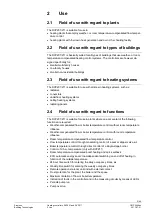
7/46
Siemens
Heating controllers RVP201 and RVP211
CE1P2464en
Building Technologies
1 Summary
2017-07-21
1 Summary
1.1 Brief description and features
RVP201 and RVP211 are heating controllers designed for use in smaller plants. The
only difference between the two types of controllers is the d.h.w. heating function:
RVP201: without d.h.w. heating
RVP211: with d.h.w. heating
The RVP201/211 controller is designed for use in smaller residential and non-
residential buildings that have their own heat generating plant
The RVP201/211 is a flow temperature controller. In terms of control, the following
choices exist:
Weather-compensated only
Weather- and room temperature-compensated
Room temperature-compensated only
On the output side, the RVP201/211 offers the following choices:
Control of three-position actuators
Control of two-position actuators
Direct burner control
The controller features analog operating elements such as switches, sliders and
setting knobs, with one exception – the optional digital time switch
Other key features: operating voltage AC 230 V, CE conformity, overall dimensions
to IEC 61554 (144 × 96 mm)
1.2 Type
summary
Type summary
Type ref.
Heating controller, without time switch
RVP201.0
Heating controller with d.h.w. heating, without time switch
RVP211.0
Analog 24-hour time switch
AUZ3.1
Analog weekly time switch
AUZ3.7
1.3 Equipment
combinations
1.3.1 Suitable
sensors
To acquire the flow or boiler, and the d.h.w. temperature, all sensors with LG-Ni 1000
sensing element can be used; for example:
Clamp-on temperature sensor QAD22
Immersion temperature sensor QAE212… or QAP21.3
To acquire the outside temperature, the following types of sensors can be used:
Outside sensor QAC22 (LG-Ni 1000 sensing element)
Outside sensor QAC32 (NTC 575 sensing element)
To acquire the room temperature, the following types of sensors can be used:
Room temperature sensor QAA10
Room temperature sensor QAW44, only together with room unit QAW70








































